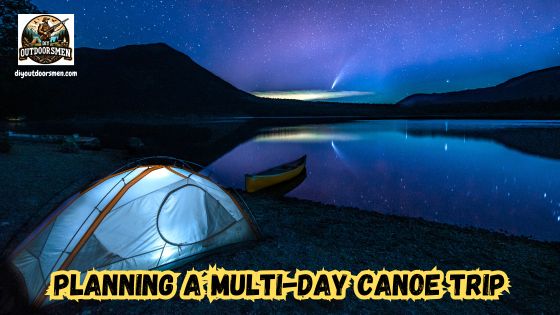Contents
- 1 Step 1: Select a Route and Do Your Research
- 2 Step 2: Gather and Organize Your Gear and Supplies
- 3 Step 3: Establish Safety and Contingency Plans
- 4 Step 4: Prepare Physically and Mentally
- 5 Step 5: Pack Efficiently and Organize Your Equipment
- 6 Step 6: Plan for Environmental and Weather Challenges
- 7 Common Questions and Troubleshooting
- 8 Final Thoughts and Your Next Steps
I have always found that planning a multi-day canoeing or kayaking trip requires careful preparation. I believe that a well-thought-out plan makes the adventure both safe and enjoyable. When preparing for a long paddling adventure, you must consider the route, gear, weather conditions, and even your physical readiness. Smart planning prevents potential problems and gives a boost to the overall experience.
QUICK LOOK: Tips for Planning a Multi-day Kayaking Trip
- Research your chosen route thoroughly while keeping local conditions and personal limits in mind.
- Create a detailed list of gear and supplies and review it several times before your trip.
- Establish clear safety and contingency plans. Share your itinerary with someone reliable who can be contacted in an emergency.
- Focus on regular physical training and practice your paddling techniques to build both endurance and confidence.
- Pack efficiently to maintain good balance in your boat and ensure that every item is secure.
- Monitor weather conditions closely and have a backup plan ready. Be flexible and prepared to switch things up if necessary.
- Think ahead about common issues so that stress is minimized and you can fully enjoy the adventure.
This article explains how I plan a multi-day paddling trip with a focus on route research, gear organization, safety, and practical training. Paying close attention to details can mean the difference between a trip that is truly enjoyable and one that becomes uncomfortable. I aim to share practical advice that will guide you through each step of the planning process.
Step 1: Select a Route and Do Your Research
The first step involves choosing a route that fits your experience level and aligns with your trip goals. Some routes feature challenging rapids or tricky portages, while others offer calm waters that are perfect for long paddling days. Consider the daily distance you aim to cover and the type of water conditions you will face. Whether you are on calm lakes, flowing rivers, or gentle currents, the route you choose matters.
Key Questions for Route Selection
- What distance is comfortable to paddle each day?
- Will you be navigating still lakes, rivers with gentle currents, or something with more movement?
- Are there designated campsites or rest stops along the way?
- What local permit requirements or regulations do you need to follow?
- How accessible will emergency help be if needed?
I often use topographic maps, online resources, and satellite images to plan my course. Google Earth is especially helpful when it comes to visualizing the complete stretch of water from start to finish. This method makes it clear what to expect at every part of the adventure.
It is equally important to check local water conditions. I review tidal patterns if paddling near the coast and check river flow or seasonal changes on inland waterways. Having a backup plan is essential in case weather conditions or water hazards force a change of course.
Step 2: Gather and Organize Your Gear and Supplies
When preparing for a multi-day paddling trip, collecting the right gear is a top priority. Being well-equipped allows you to handle challenges head-on and stay comfortable on the water. Every item—from your life jacket to your camp cooking equipment—is crucial for safety and convenience.
Essential Gear to Include
- Paddling Boat: Ensure your canoe or kayak is in good condition and suited for the expected water conditions.
- Paddles: Always pack a spare paddle in case the primary one fails.
- Life Jackets: Safety is very important, so a properly fitting life jacket is non-negotiable.
- Dry Bags: Use these bags to keep clothing, maps, and electronic devices safe from water damage.
- Camping Gear: Include essentials such as tents, sleeping bags, pads, and basic cooking equipment for overnight stays.
- Food and Water: Plan easy-to-prepare meals and snacks that provide the energy needed for long days on the water.
I also pack extra safety items like signaling devices and a reliable means of communication. Depending on the environment, additional specialized gear may be necessary. Using a checklist ensures that nothing is overlooked during packing.
Step 3: Establish Safety and Contingency Plans
Safety is my top priority when planning a long paddling trip. I develop several plans to handle unexpected issues, whether it is sudden weather changes, minor injuries, or deviations from the planned route. With a well-thought-out contingency plan, small issues can be managed before they turn into major problems.
Key Safety Considerations
- File a Float Plan: I always share my itinerary with a trusted person or local authorities. My plan includes details about my intended route, schedule, and check-in times.
- Learn Emergency Procedures: Knowing basic first aid and self-rescue techniques is crucial. I spend time practicing these skills well before I set out.
- Monitor Weather: I check local forecasts frequently and prepare alternative routes if storms or high winds are predicted.
- Wildlife Awareness: Understanding local wildlife and preparing proper food storage methods helps keep you safe during encounters.
- Medical Preparedness: I pack an all-in-one first aid kit with supplies suited to the trip’s duration and include any personal medications that might be needed.
With clear action plans for emergencies, you can protect your well-being and approach the adventure with confidence.
Step 4: Prepare Physically and Mentally
Long days on the water require both physical stamina and mental readiness. I make it a point to train before a trip so that my body is prepared for extended exertion, and this practice also boosts enjoyment by reducing anxiety.
Training Tips for Paddling Trips
- Practice Paddling Techniques: I work on refining my stroke to improve efficiency and reduce fatigue over long distances.
- Build Endurance: Regular cardio workouts and lower-body strength training are essential parts of my preparation routine.
- Simulate Conditions: I try short practice trips on waterways that mimic the conditions I expect during the longer trip.
- Mental Preparation: Setting aside time for rest and reflection helps me stay mentally in tune throughout the challenge.
This preparation not only eases anxiety but also ensures that I am ready to enjoy every aspect of the adventure with both body and mind.
Step 5: Pack Efficiently and Organize Your Equipment
Efficient packing can save you time and reduce stress, especially when you are far from home. Over the years, I have learned to organize my gear in ways that secure items and maintain balance in the boat, which in turn positively affects your paddling performance.
Tips for Packing Your Boat
- Use Dry Bags: Place all non-water-resistant items in dry bags to shield them from moisture.
- Secure Heavy Items: Position heavier items near the center of the boat to keep it stable.
- Keep Essentials Accessible: Safety equipment and emergency supplies should always be within easy reach.
- Label When Needed: While I prefer to keep things simple, labeling compartments can help you quickly locate items when time is of the essence.
- Test Your Setup: Before departure, I load the boat to assess weight distribution and ensure it is balanced for smooth maneuvering.
Taking the time to pack thoughtfully reduces the risk of issues on the water and lets you focus on enjoying every moment of your trip.
Step 6: Plan for Environmental and Weather Challenges
Environmental factors are a critical element of any multi-day paddling trip. Being prepared for changes in weather and natural conditions not only keeps you safe but also adds to the enjoyment of your adventure.
Strategies for Dealing with the Elements
- Monitor Weather Patterns: I rely on reputable weather sources to track forecasts in the days leading up to the trip. Sudden changes like strong winds or heavy rain are not taken lightly.
- Pack Weather-Specific Items: Along with standard gear, I include rain jackets, extra warm clothing, and waterproof footwear to be ready for unexpected changes.
- Plan Alternate Routes: I always have a fallback plan that identifies shelters, local support, or safe harbors if weather conditions demand a shorter route or an unexpected halt.
- Consider Water Temperature: Cold water poses significant risks. Packing thermal clothing and, if necessary, a dry suit or wetsuit is essential for prolonged exposure.
Planning ahead for environmental shifts helps you avoid dangerous situations and makes you more confident as you navigate nature’s challenges.
Common Questions and Troubleshooting
No plan is complete without addressing common concerns that might arise. Over time, I have encountered recurring questions that help guide both newcomers and experienced paddlers through unexpected bumps along the way.
Unexpected Weather
Unexpected weather can quickly change your plans. I always keep backup options ready, including alternative routes or safe zones. Extra gear and knowledge of nearby shelters can be lifesavers during unforeseen downpours or gusty winds.
Ensuring Sufficient Supplies
- Double-check your food and water estimates before you set out.
- Carry extra supplies for any delays or if the trip takes longer than planned.
- Use a checklist that covers essentials such as first aid, extra insulated clothing, and spare parts for your boat.
Managing Fatigue or Minor Injuries
- Take regular breaks to avoid excessive fatigue and to recover your strength.
- Keep an all-in-one first aid kit on board so minor injuries can be managed until help is available.
- Always listen to your body. Pushing too hard can lead to unwanted injuries or exhaustion.
Addressing these common issues in advance helps reduce stress and allows you to focus on the positive aspects of your paddling adventure.
Final Thoughts and Your Next Steps
A well-planned multi-day canoeing or kayaking trip offers a unique opportunity to connect with nature and challenge yourself in truly rewarding ways. I have learned that thorough planning allows you to relax on the water and enjoy the experience without worrying about unexpected setbacks.
My Paddling Trip Action Plan :
- Research your chosen route thoroughly while keeping local conditions and personal limits in mind.
- Create a detailed list of gear and supplies and review it several times before your trip.
- Establish clear safety and contingency plans. Share your itinerary with someone reliable who can be contacted in an emergency.
- Focus on regular physical training and practice your paddling techniques to build both endurance and confidence.
- Pack efficiently to maintain good balance in your boat and ensure that every item is secure.
- Monitor weather conditions closely and have a backup plan ready. Be flexible and prepared to switch things up if necessary.
- Think ahead about common issues so that stress is minimized and you can fully enjoy the adventure.
Let’s dive in. Every great adventure starts with a single small step. What will your first preparation step be? I look forward to hearing about your experiences as you set out to explore new waterways safely and confidently.
Planning well not only makes the trip more enjoyable, but it also gives you the confidence to take on nature head-on. By preparing thoughtfully and organizing every detail, each moment on the water becomes a memorable part of your story. Enjoy the challenge and relish the rewards that come from a trip planned with care.
Most Recent Articles:
- Complete Guide On Tracking Game Animals

- DIY 4-Step Guide To Field Dressing And Quartering A Deer

- Night Vision Binoculars For Nocturnal Hunting

- The Science Behind Camouflage Patterns For Deer Hunting

- Binocular Accessories For Hunters

- 9 Tips for Using Trail Cameras To Track Deer Movements

As always, stay safe, enjoy the journey, and please try to leave it cleaner than you found it. If you have any comments, questions, ideas, or suggestions, please leave them in the comment section below, and I’ll get back to you ASAP. You can follow us on YouTube: Man Art Creations for videos of our DIY Adventures.
P.S. Thanks so much for checking out our blog; we really appreciate it. Just so you know, we may receive a commission if you click on some of the links that appear on our site. This helps us keep our content free and up-to-date for everyone. We appreciate your support!



